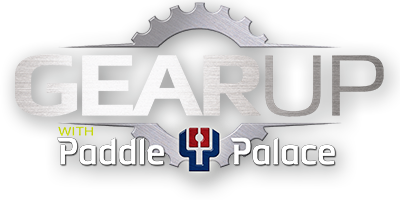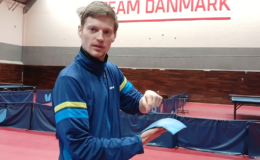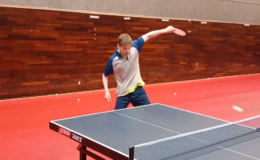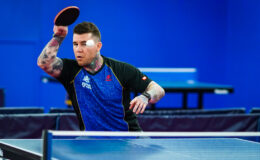Courtesy of Samson Dubina
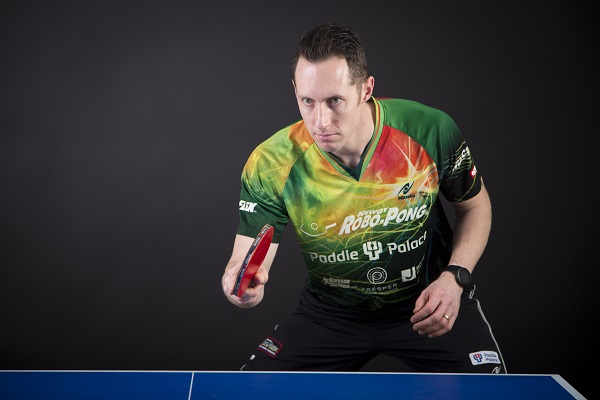
In this article, I’m going to give detailed answers 6 of the most commonly asked questions about table tennis equipment. Selecting the proper equipment is one of the best ways to maximize one’s potential.
Question #1
What are the advantages/disadvantages of carbon blades verses all wood blades?
Generally, carbon blades are faster and more suitable for the advanced player. For a beginner, it is best to choose a very slow, controlled wood blade. This will allow the player to develop solid strokes because the ball has more dwell-time on the racket. A faster blade is better for an attacking player who contacts the ball at the top of the bounce. A controlled blade is better for a defensive or all-around player who plays from many different distances from the table.
Wood blades have more feel and vibration than carbon blades. As a beginner, it is important to “feel” the ball. For this reason, I would suggest using an all-wood blade for the first three years. After a player has excellent strokes and feeling, it would be advisable to possibly move up to a carbon blade for added power. At the elite level, players who mainly use power to win points generally play with carbon blades for a hard feel. Elite players who use touch to win points generally play with all-wood blades for a much softer feel.
Carbon blades have a larger sweet-spot due to the reinforced layers and harder feeling of the blade. This will give slightly more room for error if the player doesn’t contact the ball in the center of the racket.
The final factor to consider is the cost. Most wood blades cost between $40-$100. Most carbon blades cost between $60-$200. If a player uses the racket for at least 1 year, paying the extra money is possibly worth it. The racket will last for 5-10 years.
In the first 3 years of playing, I would encourage the beginner to select the 5-ply, all wood Nittaku Rising blade. For those players wanting to use a fast carbon blade, I would suggest using the Nittaku Survellian. For those players wanting a fast wood blade, I would suggest the Nittaku Ludeak (which I personally use).
Question #2
What is the effect of sponge thickness? Is it the same for anti/long pips rubber as for offensive rubber?
Thicker sponge gives more of a trampoline effect producing more speed and spin. Most offensive players use sponge that is at least 2.0mm. Thinner sponge gives more control and feels harder because the ball sinks deeper to the wood. Many defensive players use sponge that is 1.0-2.0mm.
Another factor to consider is the weight. For senior citizens, kids, and all beginners, I recommend a light racket. Having 1.0-2.0mm sponge will help keep the racket light.
Anti/long pips rubbers are not grippy and therefore give spin reversal. By having sponge, the anti/long pips will grip the ball more and give less reversal. For the nastiest block with spin reversal, I suggest to use no sponge or very thin sponge. For the mid to long distance chopper, I suggest to use 1.5mm sponge to give more speed to the ball. From fifteen feet away from the table, the racket must have some speed to carry the ball back to the table. Although it will have less reversal, it will be able to produce more spin on its own and will be more consistent from that distance.
Question #3
What is the effect of sponge hardness/density?
The hardness/density effects how deep the ball sinks into the sponge. Softer sponge will have more dwell time and allow the ball to sink deep giving the ball a higher arch. Most loopers and those focusing on spinny shots and more arch prefer soft sponge. Softer sponge is lighter in weight and easier to perform more spin on the slow shots: loop against backspin, chop, and push. Harder sponge has less dwell time and does not allow the ball to sink deep into the sponge. Many aggressive counterlooping players like harder sponge because there is more potential for power and spin from mid-distance. Although harder sponge is heavier, one must also consider the sponge thinkness when gauging the weight.
Most rubbers have two versions, a soft one and a hard one; for example Narucross EX Hard and Narucross EX Soft. This doesn’t mean that the hard is extremely hard or the soft is extremely soft. It just means that one is softer than the other. Before purchasing a rubber, consult the review on each rubber.
Question #4
What is the difference between a light and a heavy blade?
The weight difference is due to several factors: the materials used, the head size, the number of plies, and the handle type. If the blade has a hollow handle, it will be more top heavy. If the blade has a solid handle, it will be more equally balanced from top to bottom.
Generally, close-to-the-table players use light blades, less than 70-90 grams. A light blade provide more racket speed and quickness for a good backhand/forehand transition. Choppers and lobbers use heavy blades, 90-100 grams. Because the distance player has more time to react to the ball, a heavy blade will provide more stability and consistency away from the table.
Children under thirteen years old, beginners, and anyone with limited strength should use a racket that is 70-80 grams. This will allow them to have good racket speed and develop proper strokes without battling fatigue.
Question #5
What is the advantage/disadvantage between large and small head blades?
Generally, larger head blades are heavier and smaller head blades are lighter. The close-to-the-table attackers often use small blades because they are easy to maneuver for serve, serve return, and over the table pushes and attacks. Also, when swinging a small head blade, there will be less wind-resistance. Distance choppers and lobbers often use larger blades because they have a better chance to hitting the ball, and quick maneuvering isn’t an issue.
Another factor to consider is the amount of rubber that it takes to cover the racket. Smaller head blades will be lighter because they require less rubber to cover the surface. Large head blade will be much heavier and become slightly top heavy with the added weight near the end of the racket.
Question #6
How often should I change my rubber?
Inverted rubber lasts 60 hours for the average club player. If the player uses it every day for two hours, it should be changed once per month. If he uses it twice per week for two hours, it should be changed every four months. Cleaning the rubber after each every practice session and sealing it with adhesive rubber protection sheets is the best way to ensure the full 60 hours of use.
Anti spin rubber usually lasts for 2-5 years. With no friction, the rubber actually becomes better with age. The only way for the anti rubber to wear-out is for the sponge to degrade. Check to ensure that the rubber bounces equally on all parts of the blade.
Pips rubber usually lasts about 100-150 hours. The rubber is worn-out when the pips begin to break or the sponge degrades giving it an inconsistent bounce.
Samson uses the Nittaku Ludeak Blade with Nittaku FastArc G1 rubber on both sides along with Nittaku 3- StarPremium 40+ balls.
- Read more great coaching and playing articles by Samson
